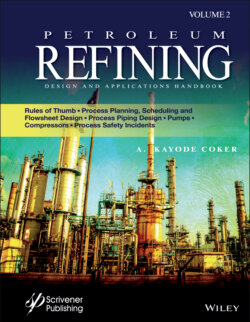Читать книгу Petroleum Refining Design and Applications Handbook - A. Kayode Coker - Страница 39
VESSELS (DRUMS)
Оглавление1 1. Drums are relatively small vessels to provide surge capacity or separation of entrained phases.
2 2. Liquid drums are usually horizontal.
3 3. Gas/liquid phase separators are usually vertical.
4 4. Optimum length/diameter = 3, but the range 2.5–5.0 is common.
5 5. Holdup time is 5 min half-full for reflux drums and gas/liquid separators, 5–10 min for a product feeding another tower.
6 6. In drums feeding a furnace, 30 min half-full drum is allowed.
7 7. Knockout drums placed ahead of compressors should hold no less than 10 times the liquid volume passing through per minute.
8 8. Liquid/liquid separators are designed for a setting velocity of 0.85–1.27 mm/s (2–3 in./min).
9 9. Gas velocity in gas/liquid separators, m/s (ft/s), with k = 0.11 (0.35) for systems with a mesh deentrainer and k = 0.0305 (0.1) without a mesh deentrainer.
10 10. Entrainment removal of 99% is attained with 102–305 mm (4–12 in.) mesh pad thickness; 152.5 mm (6 in.) thickness is popular.
11 11. For vertical pads, the value of the coefficient in step 9 is reduced by a factor of 2/3.
12 12. Good performance can be expected at velocities of 30–100% of those calculated with the given k; 75% is popular.
13 13. Disengaging spaces of 152–457 mm (6–18 in.) ahead of the pad and 305 mm (12 in.) above the pad are suitable.
14 14. Cyclone separators can be designed for 95% collection of 5-µm particles, but usually only droplets greater than 50 µm need be removed.
